In Love
With Whole Brain Teaching - Behavior Management
Made Easy...
July 2016 - I fell in love
with a classroom management system this year…
you may have heard of the Super Improver
Wall? LOVE IT and will never teach without
it or Whole Brain Teaching Rules!!!
Whole Brain Teaching in
all, is awesome and if you are looking for
something to learn about this summer that will
energize your classroom, Whole Brain Teaching is
where it is at!
I used many parts of the
Whole Brain Teaching system in my classroom and
the Super Improver Board is just one part of the
system. I suggest you read the Whole Brain
Teaching Books below. You can click on the books
and go to Amazon to purchase.
   
Also, visit the Whole
Brain Website by clicking here!
Be sure to check out the videos section of the
website!!!

I am going to share with
you how I used my Super Improver Board in my
second grade classroom. You will find the
materials to make your own Super Improver Board
for your classroom. As a bonus, I have also
included the Whole Brain Rules Posters in a
matching theme. The set is a Frog
themed set in my favorite colors of blue and
green….
My complete set is on TPT
– You
can get it by clicking here!
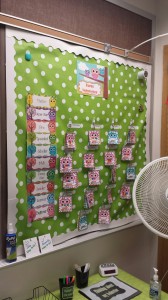
This is what my Super
Improvers Board looked like last year… I was
in a hurry and used a set off of TPT from another
seller. It was owl themed. When I
downloaded it, it was free… It is found at
– https://www.teacherspayteachers.com/Product/Super-Improver-Wall-Owl-Theme-1391398
I loved how this worked in
my classroom and I will use this system
forever!!!
Next year, I plan to use a
frog / blue/ green theme in my classroom and as a
result I have created the set found in this
packet. In the set, I share with you how I used
the wall last year. It is a must have positive
behavior system!!! You
can get it by clicking here!
Below are a few of the
slides from my Frog Themed set….
  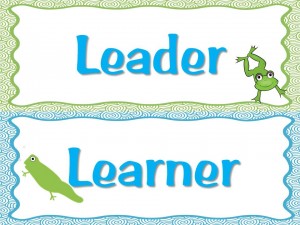 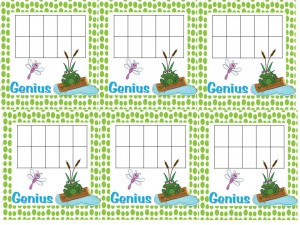 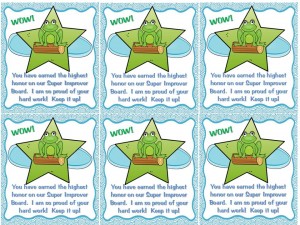 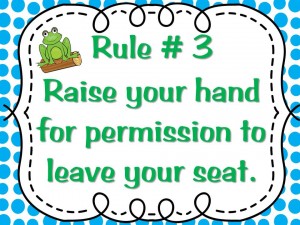
The set shares with you how
I used this system in my classroom with great
success!!! You
can get it by clicking here!
************
Tired of clip
charts, need a new behavior management system for
your classroom that is easy to use and set-up?
I have never been a
big fan of clip charts. I have tried them
in various classrooms and they worked ok, but I
always forgot to have students move clips
up. I felt they were more of a pain then a
way of encouraging good behavior. However,
I have made them for friends and even sell them
in my store. Some of my best friends
use them and love them. Over the last
two years I have been reading all I can on Whole
Brain Teaching and my ideas in this
system stem
from the layout of some of the Whole Brain
Strategies. The system I am going to
share today is my tried and true system that I
have used in many first, second, and third grade
classrooms. It works wonderfully and it is
easy to use and set-up. You can get this
system by clicking
here!
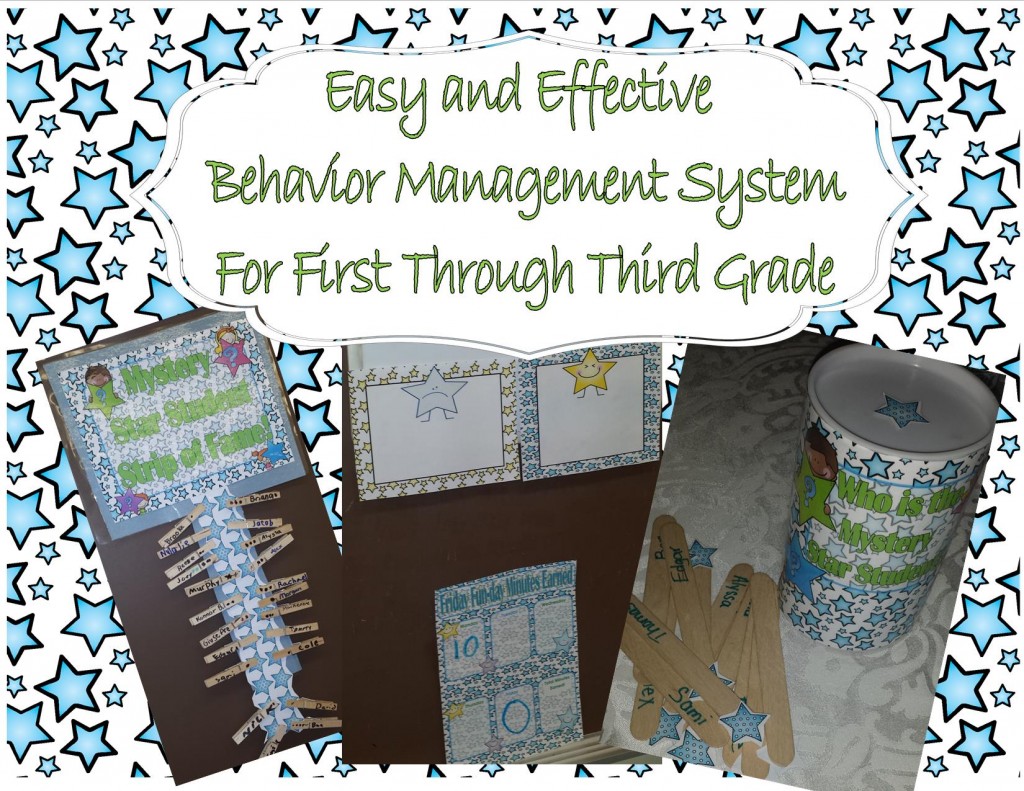
Most recently, I
used this with a third grade class and it worked
wonderfully. My students are well behaved and on
task when I use this
system! They
really enjoy the structure of the program. I want
to share how I use this plan with you and the
printables you need to create this resource in
your classroom. It includes two
parts:
Mystery Star
Student System and Fun Friday Award System Using
the Whole Brain Teaching Scoreboard System.
Both Systems are
explained to you in the set. I suggest you use
both of these systems together.
Mystery Star
Student focuses an individual student
behavior and encourages students to stay on
task just in case they are the star
student. It involves minimal set-up.
You will need to put together a jar and purchase
craft sticks. All printables needed to run
this part of the system are included. Also,
my directions and set-up of the system are also
found in the set!
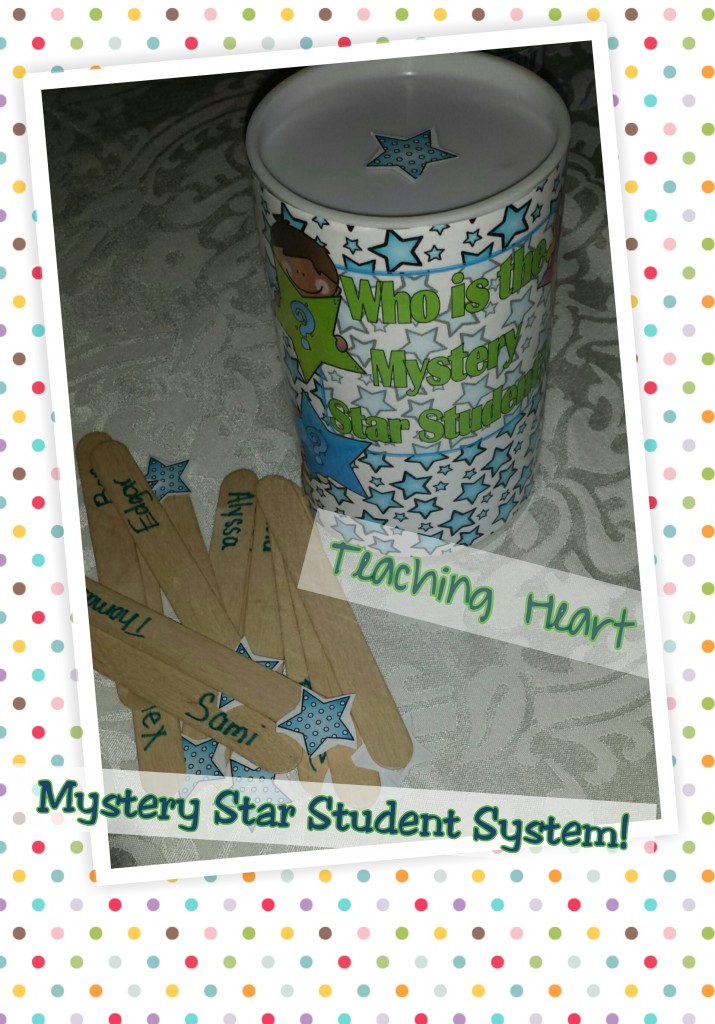
The display below
is also explained in the set. All
printables to make all items seen in this post
are found in the set!
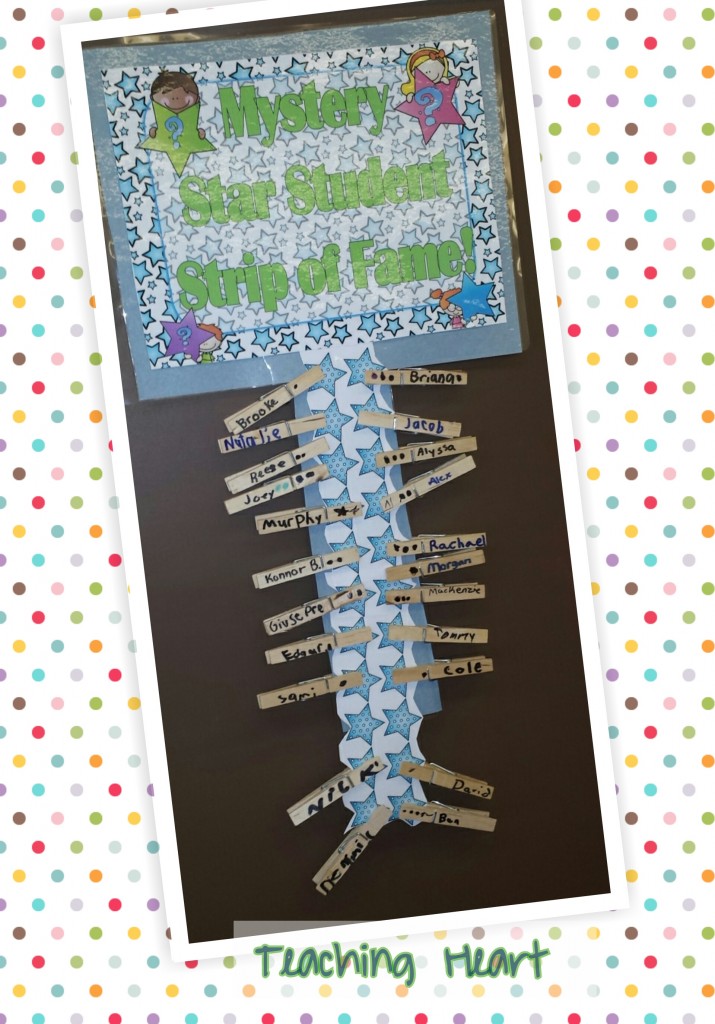
The second part of
my system focuses on whole class behavior and is
modeled after the Whole Brain Teaching
Scoreboard. I explain it is more detail in
the set.
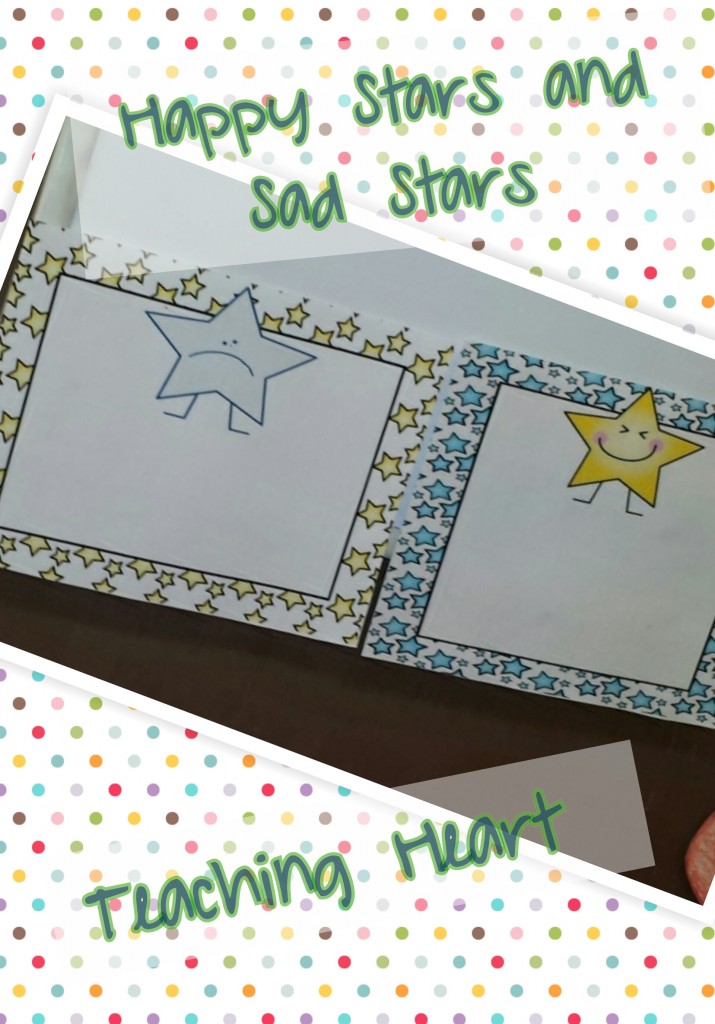
In this set I
explain how I to use the printables in the
classroom. All you have to do it read about the
system to understand it. I believe it is very
easy to start-up and understand. A few items to
print and laminate and you are ready to go. When
I took on a long-term substitute third grade
position, I created these printables and had them
printed and ready to go in less than an hour.
That includes the time to laminate and cut! So if
you are in a pinch—this should make you
happy!!!
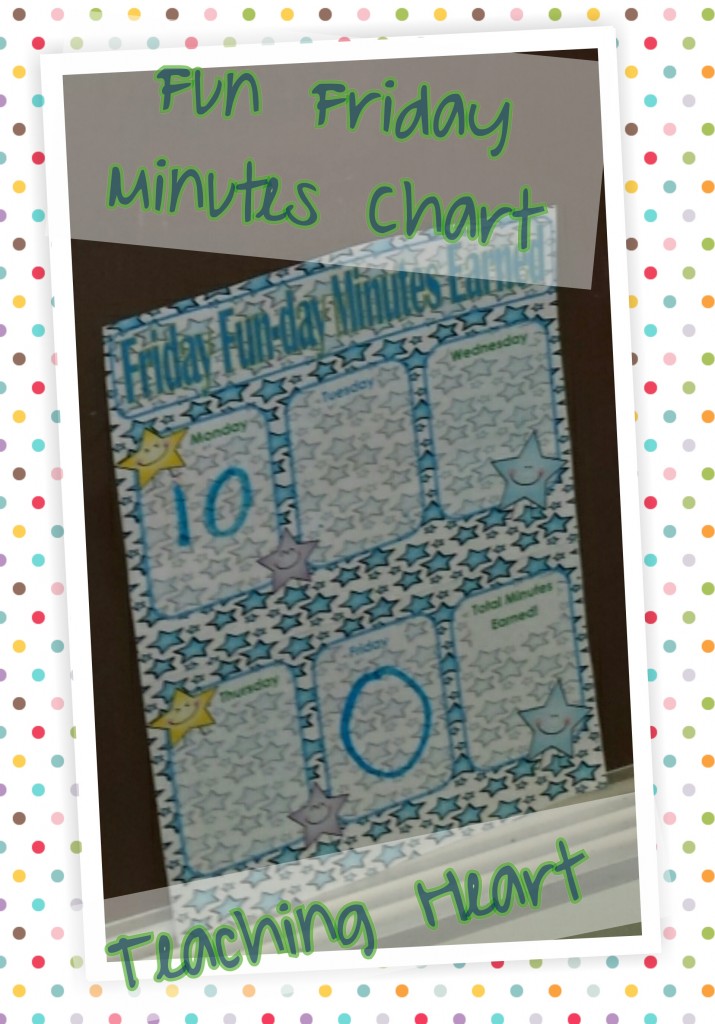
Here is a break
down of what the pages in this behavior
management system include!!!
Page 5 and 6—
My Mystery Star Student System is explained here.
Page 7—Printable Cover for your Mystery Star
Student Jar.
Page 8—Star Student Award Card Printable.
Page 9 and 10 —Mystery Star Student Strip of
Fame Printable
Page 11 and 12—Star Student Rules Display
Page 13—Numbered Stars to place on the
sticks you will place in your Mystery Star
Student Jar.
Page 14— Write your students names on this
sheet so you know what numbered star goes with
what student!
Pages 15, 16, and 17 – My Fun Friday Star
Scoreboard Explained. Links to resources
included!!! I also share how I use this part of
the system as a substitute. Basically the same
method just used in shorter spurts.
Page 18—Smiley Star Scoreboard Page
19—Frowny/ Sad Star Scoreboard
Page 20 and 21—My Fun Friday Minutes Earned
Printable Display
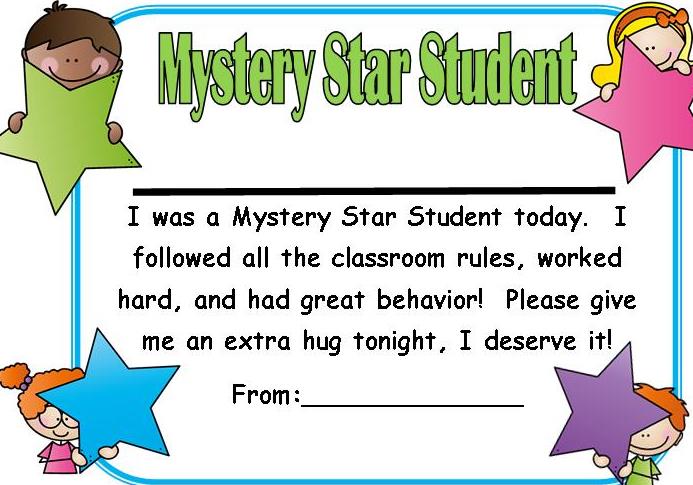
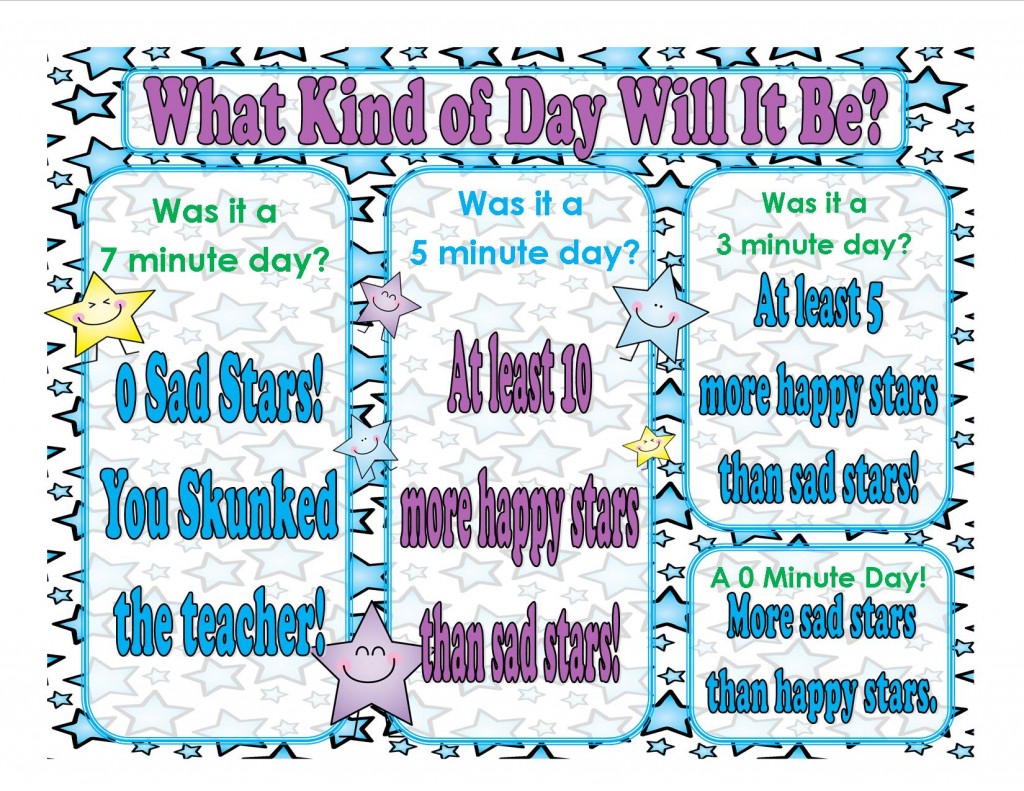
I hope this set makes your life easier, your
students happier, and your classroom more
productive like it did mine!!!
To learn more and
to purchase,
click here!
See how I have used
the system above while subbing - click
here!
|
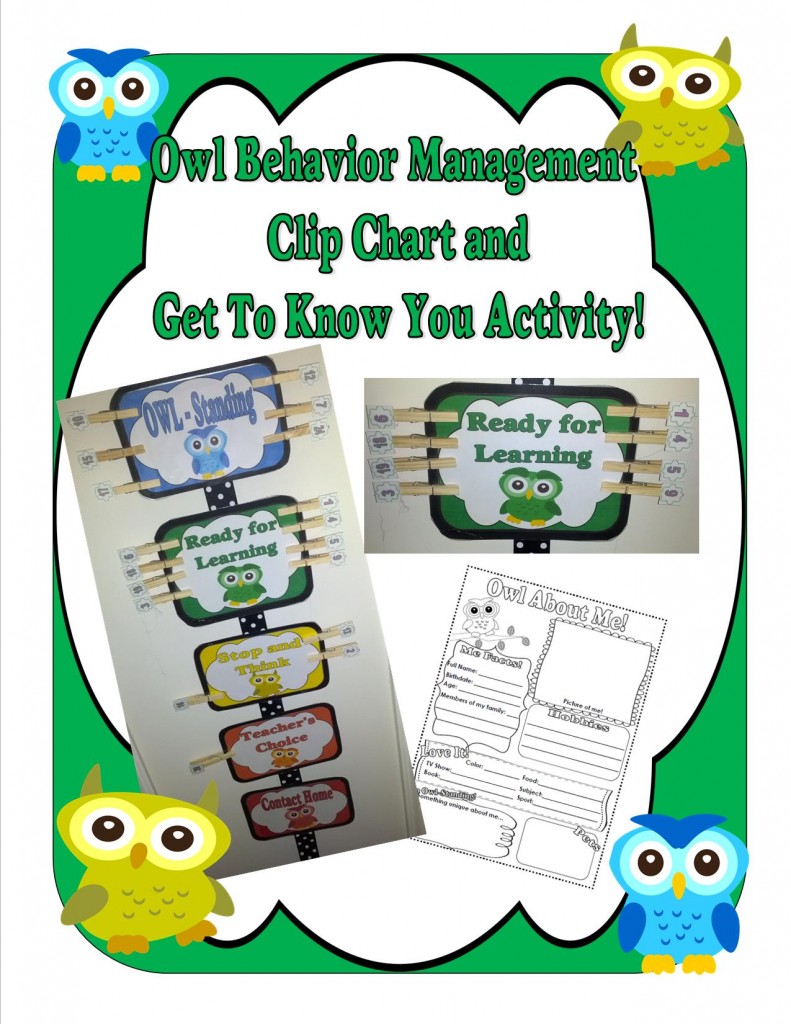 Owl
Behavior Management Clip Board
You May Purchase This Set and Make Your Own -
Click
Here to Learn More at Ejunkie
This
owl themed behavior clip chart is divided into
seven sections. Print on cardstock and
laminate for years of use. Each student in
your classroom should have a clothespin with
their name on it (or class number/ class numbers
are found in this set). Each day
everyone’s clothespin will start on
GREEN—/ Ready for Learning and should be
clipped onto the left or right side of the
card. Throughout the day, you can have
students move their clothespin up and down the
chart based on behavioral choices being
made. Inappropriate behavior will cause the
pin to move down and appropriate behavior moves
them up the chart.
When
a student gets to the top of the chart,
pink—Ruling the Roost, give your students
one of the Ruling the Roost cards to take home
and share their great achievement.
Hanging
the chart is fun. I used ribbon and key
hook to put the pieces of the chart
together. It is your choice how you wish to
hang your chart depending on your classroom
space.
A
weekly student behavior tracker is included if
you choose to use it as a home communication
device. Students would color their own at
the end of each day and on Friday the sheet would
go home and come back returned.
This
owl themed set also includes a GET TO KNOW YOU
bulletin board set. Look whoooo’s in
our class! I suggest you mail the form out
to your students with your welcome letter before
school starts. Have them bring the form
back to school finished on the first day.
They can share their completed sheet with their
classmates and you can collect the sheets to
display for Open House.
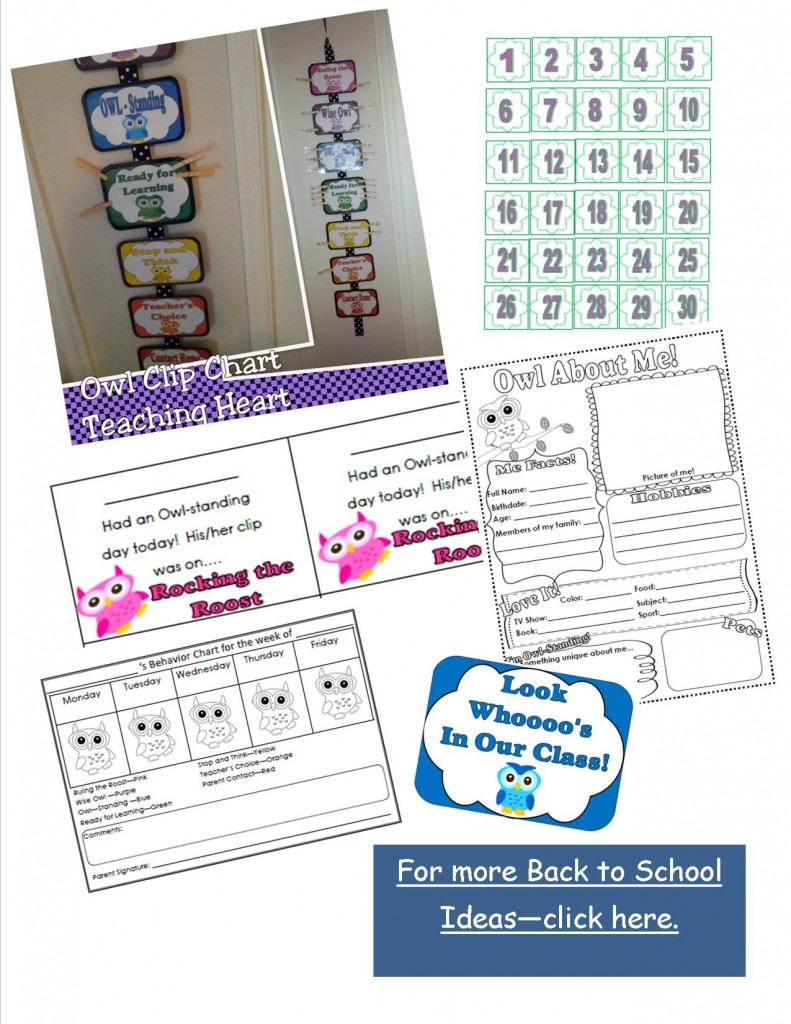
For
more Back to School Ideas—click here.
You May Purchase
This Set and Make Your Own -
Click
Here to Learn More at Ejunkie
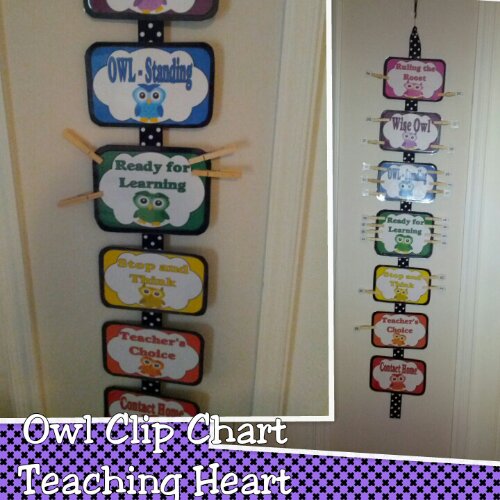
|
 Below
you will find a chat about behavior management
systems. Many teachers across the world shared
the systems they use in their classroom. If you
are just starting out with your teaching job, I
suggest you read them all and pick and choose an
idea that would work best for you. Make the
choosen idea fit your needs. When designing your
behavior management system keep in mind the three
C's; consistency , caring, and community. Below
you will find a chat about behavior management
systems. Many teachers across the world shared
the systems they use in their classroom. If you
are just starting out with your teaching job, I
suggest you read them all and pick and choose an
idea that would work best for you. Make the
choosen idea fit your needs. When designing your
behavior management system keep in mind the three
C's; consistency , caring, and community.
|

I,
too, incorporate many different things into my
classroom management plan.For my main plan, I
find the "pull a card" system works the
best. I love it, because it allows me to be
fair and it enables me to discipline without
anger or emotion. Also, I can easily fit
both negative and positive consequences into this
plan.
I
also do "group points." There are
five groups in my room and they earn points when
the whole group does something appropriately...
going quietly through transitions, etc. At
the end of the week, the group with the most
points gets to eat lunch with me in the classroom
To
get the kids to settle down quickly (I.E.- when
we're lining up), I believe that a variety of
tricks works best.Sometimes I'll say "One,
two, three... eyes on me" and they'll
respond "One, two, eyes on you!". Other
times, I'll do a combination of snaps and
claps that they have to echo after me. OR,
I'll occasionally whisper, "If you can hear
my voice, ____________" (touch your nose,
raise your hand, etc.)
For
an academic incentive, I do "chance
cards." When someone is really
"stretching their brain," they get a
little coupon-type card that says,
"Congratulations! _____________ has earned a
chance card." They put these in a
bucket and at the end of the day, I draw out one
or two cards to pick out of the prize box.
At the end of the week, all chance cards are
thrown out.
grace,
Chad
|

I do a
"card" system with my k's. Funny, never
thought that I would, but it seems to work great-
sometimes better than with older kids.
I have a chart on
the wall with a pocket for each child. I
make the pockets from library card holders. I
attach them with
paper clips poked through the tagboard so that I
don't have to
make a new chart each year, I just get new card
holders.
Across the top are 5 colored faces (ellision cut
outs): any
colors will do, but here are mine-- yellow very
happy face,
orange happy face but with a smaller smile, green
straight
face, blue sad face, purple sad face with tears.
Each pocket
has 5 bears corresponding to these face colors.
Everyone starts on
yellow everyday. Verbal warnings are tried,
and sometimes I may do a quiet time without
changing the color
in the pocket. There is a growing set of
conserquences with
each color change. Most of the time once a child
gets to green
(2 changes) the child chooses to change. Green
will result in
a note or phone call home that same day to the
child's parent.
Every child has a
behavior progress report. A manila folder
and on the inside left is a piece of paper with
my class rules
listed, consequences per color change and the
rest of the paper
has lines for teacher and/or parent comments. On
the right
side of the folder is a piece of paper with those
faces going
across the top (made with microsoft word) and
then the week
ending dates for that quarter typed in. Next to
each date is 6
boxes- 5 smaller ones, 1 per day of the week. I
used a marker
to color in that child's color for the day. The 6
box is for
parent signature.
Folders are sent
home every Friday to be returned monday. I
send home a letter, with periodic followups, to
encourage
parents to calmly discuss the reasons for the
behavior and to
talk about the difference between home and school
rules which
seems to be my biggest problem year after year.
Terri F.
California
|

Here is
another idea, very effective for young children .
The
focus is not on the negative behaviour and its
consequence.
Rather a focus on doing the right thing all the
time and
being rewarded for that .
I have little
pieces of paper with "Caught you being
good" on
them and a blank space
A container on the desk
A container of jelly snakes or a goodie
Children are
awarded "caught you being good" papers.
They can
write their name on and then place in the
container. At the
end of each day we have a draw and the persons
name that is
pulled out gets a jelly snake.
This presents me
with a challenge to be aware of all children
and catch each child doing something
appropriate(no matter
how small). Sometimes we have two and thre drawn
in the one
afternoon .
Posted by Carol on 6/02/02
|

I use
several different things in my room. But I really
have good luck with one particular system.
My kids sit in groups, some together like a
table and others in rows. But each group
has a number. I put marbles in a cup with
their number when I notice that they have
responded to the directions quickly and quietly.
If they all go down the hall quietly, I
might put marbles in every jar. Sometimes
if one person in a group does something special I
may reward the whole table. Every couple of days
I will check to see which group has the most
marbles, then I pour the marbles into a
cup, then a pint, and finally into a quart.
When we fill the quart, I have something
special for them.
Last year we had a
reading party with pillows, parents ( a few),
favorite books and cookies and milk. Other
times we would have extra recess or center time,
whatever. The kids really respond to this
and in the end everyone gets to participate in
the reward. They also learn very quickly
that two cups makes a pint and two pints make a
quart.
I also do a lot of
Dr. Jean's celebrations, like the ketsup bottle
clap, or the fireworks, or they stand up and do
something silly. I really don't like to
mess with stickers, it seems too time consuming
to keep up with.
I also use some
different things when negative consequences are
necessary. I want to read Love and Logic
this summer and may be able to come up with
something new.
I'm sorry to say, I
am just like you when it comes to thinking about
next year already. But I enjoy having the
time to regroup and rethink. Good luck.
annie/la
|

Here
is a little poem that I've used in the past for
those hard to handle classes.......
I put a clown up high on the wall, (any visual
will work)... and aside of the clown I had this
poem written....
For
all the nice things people say,
I'll
add another link today.
And
when the chain and floor do meet,
(Mrs.
Rhodes) will bring us a treat.
I
took1" strips of paper to make a paper chain
and looped one loop around the clown's hand.Each
time the children were caught doing something
good, or being nice by another member of the
staff, they would add another link. After the
link got lower and the children could reach it,
they would add the link themselves.I talked about
cooperation, and how everyone needs towork
together etc. But you must
discuss that other staff members must say
something without the children asking or telling
that they are behaving. If the kids do
that, they don't get a link. You can make it as
challenging as you like, the higher you put the
clown on the wall, the longer it may take them to
get the treat. If you want to start out
small, lower the visual so the chain doesn't have
as long to hit the floor, but later you may raise
it if you want to lengthen their time of meeting
the goal.
Yvonne
Rhodes
Catawissa PA
yrhodes@uplink.net
|

I
have recently started using an approach to
discipline in my class that focuses on developing
self-discipline and responsibility in children.
It is extremely positive and quite different than
the approach you said you have used in the past.
The program I am using comes from a newly
published book by Dr. Marvin Marshall. He
has an extensive website with many excellent
articles that come directly from his book if you
are interested in exploring this. If you
are unhappy with the behaviour modification
approach (french fries etc.) this might be an
answer for you. Not long ago I wrote quite
a long letter about Dr. Marshall's approach
encouranging someone else to find out about
it.I'll copy and paste it here in case it's of
interest to you.
Kerry
in B.C. Canada
|

Caroline
Starowicz <caroline@webtelemics.com>
wrote:
You could put shapes ( such as fish), cut
from construction paper, with the kids names on
them on the wall beneath the blackboard.
When you "catch a kid being good", you
ask them to put a star sticker on their
shape. Once they get five stars on their
shape they earn a nice sticker. When you
want to change the shapes, they can take them
home. This is an idea I learned from my
cooperating teacher when I was a student teacher.
The
teachers at my school this a lot. But one
of my pet peeves is the child who hollers
"Look at me, I'm behaving." or
"Did you notice that I sharpened Becky's
pencil for her?" How do you handle
that?
Val
|

Here
is a point system I have used it the
past… All positive points! Also,
it is great for keeping the room pretty quiet
when they are doing centers and I am teaching
small group.
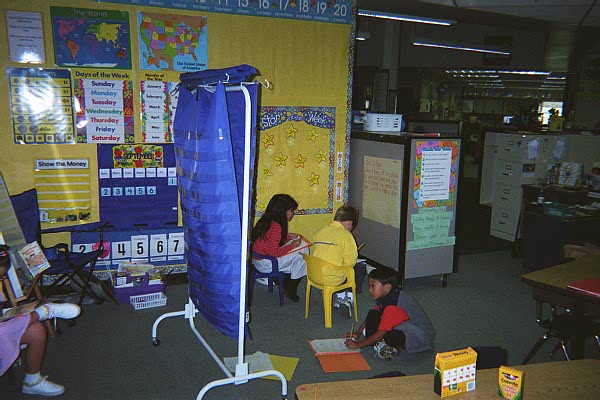
picture of students at pocket chart and poem
center.
My
students sit in teams. I have 22 students.
There are 4 teams. 3 of the teams have 6 at
them and 1 has 4 students. Each team has a
group number. Before I start reading
groups, I tell them I will be looking for my
favorite group (quiet and on task). That
groups gets ten points and the second place gets
five points. After I finish with each
reading group I offer positive verbal
feedback (Wow, look at group 2 everyone is
working hard and their group is very
quiet). There is no more than 4 kids at a
center and most of the time all students are not
at the center at the same time because some work
faster than others. I never have trouble
with noise level at the centers. After
reading groups, I go to the board and transfer
the points under their specified group
number. Throughout the day I offer points
to groups that are ready to learn. For
instance during a math lesson, I tell them I that
I am looking for the groups that are
participating and on task during the
lesson. I just make it up as I go - adding
points for positive things the groups do.
At the end of the day we count the tally marks
and the first place group wins for the day.
They get a star on their chart. When a
student fills their chart they get to go shopping
in our class store for one item and then they get
a new chart and the process starts again...
The next day starts with a clean slate and any
team can win. I love it, it works great and
the kids seem to like it.
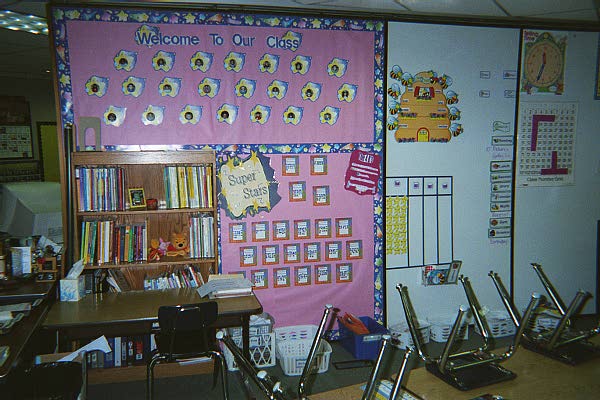
Below the Welcome to our class board, you will
see the star chart area!
The
class store is filled with Oriental Trading stuff
(very cheap).
I
also offer the students stars on their chart
during reading group. When they get to
group they start with 0 stars and can earn up to
three.
To
help make this run smoothly, one of my class jobs
is star monitor. He/she will pass out the
stars to the winning group at the end of the day.
Colleen
www.teachingheart.net
|

Speaking
of Dr. Jean...I totally love her
"stuff!"
Here
is a link to her celebration chants/cheers; http://www.drjean.org/html/monthly_act/act_2000/anytime_2000.html
I
do something very similar to Annie. Each team of
4-5 children (they sit in desk groupings) has a
cup on their tables. I reward positive
behaviors with little
green tickets I made several years ago. We set a
class goal, say 50 tickets to start. (I increase
the total as the year goes by.)
At
the end of each day the day's team captains (1
fromeach table) reports how many tickets their
team has. I write them down, then we add them up
and I post theclass daily total. When we get to
the goal we eat in the classroom the following
day. That is always a big deal. I've used popcorn
parties, extra recess, maybe
some extra center time, etc. Whatever works for
the class.use to do stickers, candy and the like
but found that this works best for me and my
"kiddos."
Classroom
management is one of those trail and error
things. You have to figure out what works best
for you. The 3 C's key to any successful system
are consistency , caring and community.
Malinda
|

Some other
tips that have worked for me: Colleen www.teachingheart.net
Grab a Name -There
are many alternatives to Red Robin Reading.
Here is a good idea. Keep a mug of tongue
depressors with each student's name on a tongue
depressor. Then pull these for students to
take turns reading or answering questions.
Students pay better attention when they don't
know who will be "pulled" next.
The "sticks" work great when you pull
names for small group activities. Also,
another good idea is to pull the names and
arrange them in groups on your desk, then
announce who is working with whom for the class
project or experiment.
Still Waters
(transitioning from one activity to another) K-3
There are times when teachers need their
students to be quiet quickly. For instance,
when you are getting ready to go out into the
hall and transition into a new environment.
I learned this simple trick in the school I
student taught in from one of first grade
teachers... Thanks Barb S. 1. First
you need to inform the class of a game called
"Still Waters". Tell the class
that you will be playing this game often and they
will know when the game starts by whenever you
say, "1,2,3,3,2,1 Still Waters has
begun. (This should become a regular
routine for your class) 2. When they
hear this statement they are to freeze and not
say a word or move. 3. You will be
timing them to see how long they can stay still
as a team. The goal is for them to break
their best record. 4. You will
hold your fist in the air and each time you see
someone move or talk, you put a finger up
and stop when you have all five up. Then
check your watch and give them the number of
seconds they lasted. 5. By this time
you will have their attention and can give them
directions for the transition...
Math Mania K-5
Do you ever find yourself with a few min.
before lunch and you are done with your morning
lessons. Here is a game to play while the
students wait in line to go to lunch! This
is a great one for subs to have handy!
1. Have the students line up. Have
the first student in line choose a number from
1-10. 2. Announce an
operation. Such as add 2. 3.
The second student in the line adds two to the
first students number. 4. Continue
down the line having each student add 2 to the
new total. 5. If they answer incorrectly
the student sits down and the student behind the
"out" student tries to take over where
the other left off. 6. The winner is
the last person standing.
Clap My Beat 1-5
(K?) One of the best behavior management
techniques I have learned is the one I am about
to share. I learned this from my
cooperating teacher when I student taught.
It is great for getting your class to stop what
they are doing and pay attention. It is so
simple and they love it! Thanks Barb H.
1. Inform your class of a new
game you will be playing. Tell the class
that whenever you have something important to say
or you want the class to have their eyes on you,
you will clap a beat and they will mimic the beat
you clap. Once you stop clapping their eyes
should be on you and their mouths should be
zipped! 2. For instance, (you -
clap, clap, snap, clap) and (they-clap, clap,
snap, clap) 3. You keep clapping
beats until you have everyone clapping with you
and eyes on you. Now you can start a lesson
or so on. IDEA: I found that when I
used this it was most effective if as I was
making the beats I would say, "I bet you
guys can't do this one!" They loved
the challenge. Also, it worked best when I
would praise the students on how nicely they
clapped along. Especially if there is one
student who always claps along with your beat as
soon as you start. Positively reinforce
that student and others will follow as
quickly.
Green Light,
Yellow Light, Red Light... STOP!!! If your
classroom sound like a traffic jam - this idea
may help you out!! 1.) Make a poster board
sized traffic signal. 2.) Cut out an
arrow 3.) Glue the arrow to a spring tight
clothespin, and clip it to the traffic signal.
4.) Tell the class when the arrow points to
the yellow light, they need to listen carefully
to directions. 5.) Inform that the green
light tells them to begin their work.
|

I have
been a teacher since 1973 and the behavior plan I
use is definitely
STRESS free (for both you and the students) and
doesn't take time out from
teaching. I start the year off with every
child's name on the board. I
give a tally mark when there is good
behavior. When someone is doing
something inappropriate, I give all others a
tally mark. The children catch
on pretty quickly, you don't have to say a word,
and just about no time is
lost. I do this a lot at the first of the
year and it gets fewer as the
year progresses and they internalize the
behaviors I want. My class is
always the best behaved, usually even when I'm
not right there. In second
grade my students need to learn tally marks and
this is one lesson that's
very easily taught when we get to it because we
have used them from the
beginning of the year.
Oh, when they reach 10 tally marks, I erase them
and they get to pick
something out of a goodie box. I have
polished rocks, older books, left
over stickers, not much but they don't seem to
mind. No one can tell where
anyone is in relationship to behavior because
after 10 each starts over. It
works really well with no "feelings"
involved--either yours or your
students'.
Pam
I am so glad you
posted this. I need help with it. I have read
quite a few beh. mgt. plans that have the teacher
catching the kids being good. I tried it one year
but it was so hard for me because the bulk of my
class is always so good! It's usually just a very
small number that causes 99% of the problems. I
found myself consumed with catching good behavior
because it's always there. Then I started
worrying about what I was teaching them - they
are SUPPOSED to behave and I wondered if it was
really a good thing to reward them every time
they behaved the way that children should. And,
if I didn't reward them every time I caught them
being good, how would I pick and choose what to
reward them for? I'm telling you - I've got some
awesome students every year who could be rewarded
CONSTANTLY. Being kind, sharing, being polite,
listening, helping each other, finishing work in
a timely manner, etc., are traits I want to
instill in them but not necessarily reward them
for. Does this make sense? I am always told that
one of my strengths as a teacher is how positive
I am with all of the children (I tell you this so
you won't think I sit around and holler at the
misbehavers while ignoring the ones who behave
since they should be!!). I should also say that I
am the parent of two girls (10 and 11) and I have
never paid them for good grades or given them
allowance based on doing chores at home that they
should be doing to contribute to the household. I
feel like their duty is to make the best grades
they are capable of and it's not something I
should pay them for (and they both have made
straight A's so far....we do go celebrate report
cards at TCBY but many of their classmates get
LOTS of money for every A they bring home).
Around the house, we all share some of the chores
to make it a nice place to live and none of us
gets paid for it. If they want to make money,
I'll give them a job that I don't expect them to
do like washing the van or washing all the
windows outside, etc. I hope this is coming
across how I feel about it - I am a VERY positive
minded mom and teacher! Bottom line, I would LOVE
a behavior mgt. plan that focuses on the positive
but I am having a hard time with the mechanics of
it Sara}
|

| I have a chart up
on my board. It is divided into 5 sections. The
sections are labeled +3, +2, 1, -1, and -2. The
students each have their name on a magnetic card,
or you can use gallon milk caps with their
pictures inside made into a magnet.
They all begin the
day in 1. During the day their name can move up
when they make good choices or down when they
make not so good choices. I like this because
they can redeem themselves, opposed to the color
cards.
The first thing in
the morning it is two students job to fill out my
form that keeps track of where you were at the
end of the day. They then move the names back to
1.
At the end of each
nine weeks is a reward day. The first and third
quarter we have game day. I pull out all the
games and they each have a cost posted. They use
the points they have gained to buy their time on
a game. The better the game the more the
cost(popular).
The second and last
quarter I have an auction...these are my
favorites. I have items that I collect or ask
parents to remember us as they spring clean! The
students use their points to bid on the itmes. I
make sure everyone gets something. I have books
we have made in class, pictures I took, book club
books, things from yard sales, etc!
This system has
worked well with me. I have had a few cases where
I needed a daily behavior chart for individual
children. But other then that this works for me.
I do like Pam says and concentrate more I
catching them being good, then the others fall in
turn to good behavior.
Any questions just
ask!
Terry/FL Looping 2
to 3
P.S. They can save
their points from one event to the next, which
works well if someone is absent.
|

MarkSam5@msn.com
06/04/02 17:38 PM
I use the barrel of monkeys you get at
Wal-mart. Each time a groups is
caught doing somthing
well, they get a monkey. They hand it on
theirdesks. The group with the most hanging
monkeys goes to treasure chest.
Excellent idea! Do
you do this everyday or do they go to the
treasure
chest at the end of the week?
each day, after the
first few weeks I begin to allow the awards
to be free read time, extra center, extra
computer time, that
way I don't get low on the treasure chest.
Samantha/TN
|

I use the
Marble Jar as a total group incentive, but I
empty the jar. I find its motivating for the kids
to see how close they are to their goal. As we
get close to an empty jar, we count how many
marbles are left in the jar, set a goal for how
long it will take and discuss behaviors that will
earn marbles. Also on "exciting days"
near holidays, Field Trips, Picture Day, whatever
it is that has them overexcited, we have
"Double Days". Because it's twice as
hard to follow the rules at those times, I take 2
marbles out each time the whole class cooperates
in some way. Compliments from another teacher or
the principal are always worth 2 marbles, so on
these days the class earns 4! When the jar is
empty, we celebrate with a "Marble
Party" (cookies& punch, or popcorn &
soda) the next day, refill the jar, & begin
working toward our next one. This year's class
(K-2) earned 18 Marble Parties!}
|

| Posted by
New Teacher2 on 6/05/02 I
will be in first next year as well and this is
what I plan to do:
On a large piece of
green posterboard, I put green and whitelibrary
card pockets (I got them at a teacher store. They
even have sticky backs). I put 5 rows of 6 cards
each and each pocket has a number. Each child is
assigned a number (so I can reuse the chart for
years)> Then I laminated it and slit open the
pockets. Each pocket has 4 cards, which are
turned if a child chooses to break a rule. The
colors mean:
Green-Great Day!
Yellow-Warning! Be careful!
Blue-Lose 5 minutes recess time
Red-Lose all of recess time/note sent home to
parent (This is
a pre-made note I copied on red paper that says:
_______ had trouble
following our class rules today. Please speak
with him/her so tomorrow will be a better day.
At the end of the
day, any child on green gets a sticker on a small
incentive chart. These hang by the chart. I got
the charts at a teacher store. Each has 20 small
squares and I use the tiny stickers for these. At
the end of each week any child who has been on
green all week is entered into a drawing for
little prizes. I choose 4-5 names a week. These
are pencils, erasers, little cheap toys, etc.
Each of my students
also takes home a Daily Digest sheet I made up.
It lists homework for the day (I give certain
tyoes of homework each day of the week) plus has
a square they color in to show their parents what
color they were on. It is initialed by the parent
nightly. My kids also have a 3 x 5 notebook in
their home folder which is used for
parent/teacher communication and concerns.
I like this system
because it is very visual. By the way, I do count
it against students for not bringing homework
since
that is considered being not responsible. My
class rules are:
1. Listen carefully
and follow all directions
2. Raise your hand before talking
3. Be Kind
4. Be Responsible
5. Follow the Golden Rule (Treat others as you
want to be
treated)
I also do little
things to reward the whole class. I have a marble
jar and the class earns marbles for different
things-
working nicely as a group, getting a compliment
from anotherteacher, nice hallway behavior, etc.
I vary the number of
marbles given and sometimes let individual kids
add a few if they have done something special
too. My only rules are I never take away earned
marbles and if my kids ask for them they are not
given. Hope this helps!
|

Posted by Marcia on 6/05/02
Hi! I teach in
Colorado and we use a green, yellow and readlight
system. I teach first grade. Every one begins on
a green light. If they break rules, they turn
their light to yellow. From there it goes red, a
note goes home and they miss half the next day's
recess. They would rather eat dirt than have to
change that light!
Marcia
|

Kathy, SD,CA on
6/05/02
I also used the
card system for first grade. To me, it was an
ineffective tool. The same kids were turning
their cards and it became habitual for them.
Parents also weren't much help. When Johnny would
meet his mom every day after schoolit was
immediately..."What color today?" I had
kids who were
totally anal about this. I have been subbing for
now and have seen different methods being used. I
rarely see the card system any longer. What I
have been seeing is more positive discipline
techniques where kids are rewarded rather than
punished throughout the day. One class that I
subbed
for had a really good system that worked for
them. All throughout the day when kids were
following rules and such they would get their
name on the board and when caught doing what
they're supposed to, the teacher would draw stars
next to their names. This is a more positive
approach to
discipline than constantly focusing on the
negative. Those who got stars would get to choose
from a bowl at the end of the day for free
homework coupons, extra center time, etc.I was
also in a class that had a reward system like the
above poster where there was a
"drawing" and a few kids were
called. There were A LOT of hurt children because
they did well but their name wasn't chosen. I
definitely don't advocate doing that. It's not
fair that a lot of kids doextremely well and then
get nothing.When I did the card system, I also
did the charts with the stickers, but I just
either forgot or didn't keep up with the stickers
because of being too busy or something of the
sort.You'll learn as you go along what works for
you. Every person has their own thing that works
for them. I really advocate taking a more
positive approach to discipline and working from
that. You'll have a lot more happy and less
stressed out kids.
|

| Use tons of
positives throughout the day. Examples include:
"I love the way the students at table 2 are
working quietly!" and "Sue, it was so
responsible of you to bring back this worksheet.
Thank you!" When students know that the
positive stuff is what gets your attention, they
will want to act in an appropriate manner. Also,
have you read anything by Jim Fay (Teaching with
Love and Logic)? He has wonderful ideas for
helping children
become responsible for their own behavior. He
uses comments such as "Students with clean
desks will be going to recess
today." and "I listen to students who
raise their hands." Ruth/1st/NE
|

kathyfl on 6/06/02
I use the light
system only if the verbal, written and whole
class postives such as filling the marble jar,
turning over #'s on a 100 chart, etc. aren't
enough for a particular class. Before I change a
light, I always ask the child if she/he knows
why. In the past parents have told me Johnny
couldn't tell them what he did that was not
appropriate.
YELLOW is a warning
and a chance "to turn the day
around".This gives them the opportnity to
get back to green at the day's end. When a child
gets 5 green lights he gets to go in the prize
box.
For management I
take a manila file folder and tape a class list
inside which has been set up as a table for the
month . I use red, yellow and green markers to
"dot" the day. The serendipity was that
it made great documentation for conferences. The
children are taught to use read this using a
ruler, and it's left by the lights. I use three
paper plates with a colored circle indi the
center and write the students names in
clothespins moving them as necessary. I don't
have a lot of wall space!
For major rule
infractions such as hitting, etc., I send home a
STOP/GO note which the child and I work on
together. We sign it, and the parent signs and
returns it to school the next day. I take a copy
of the S/G before it's sent home if at all
possible. You can guess why!
The next grade
level up in our building uses fake coins from our
math program and a class store. I would use this
if we could because of the math reinforcement!
|


| Teachergal on
6/06/02 I use a
stoplight poster in my classroom. Red means seats
and quiet, yellow is whisper at your seat, and
green is walk and talk. The kids really watch to
see which light the arrow is on. If it gets too
noisy with the arrow on whisper at your seat (
where it is most of the day) then I move it to
red. It makes it seem like the light is
requesting quiet, not me!! I move it to walk and
talk during parties and indoor recess. If I
forget someone always reminds me.
|

| I use a very quiet
Canter System for management in the class and
outside in the hall, lunchroom, and elsewhere. I
will put it here. The article with a picture of
the Canter Board is on my home site (at the
bottom) or free on request by e-mail. Rick
Lynn Teacher
Canter System great
for elementary students
I use a Canter
system to manage my elementary classrooms. I
provide good, positive reinforcers and make these
rewards contingent on good behavior. I begin by
drawing up a Canter Board with my students' names
on it with little squares beside each student's
name. You will probably need more than one board
for a large classroom. A model of this is shown
on the last page. Before I actually draw names
and reinforcers on the board, I take it to a
local office supply store or the school and have
it laminated. Then I can use an erasable ink to
write the students' names, reinforcers, and
checks on the board. I go over with my students
the rules of the classroom and post them on the
wall so each student is informed of what is
expected. When a new or unforeseen situation
arises, we talk it over or I make a decision
whether or not such an action will be allowed.I
need to point out that younger students have
short attention spans. I do not work them more
than 45 to 55 minutes without a break. I find
this also helps to alleviate misbehavior. In
addition, I do not use my system for lack of or
not performing academic work. I want to make
learning self-motivating and desire to maintain
better student relations for learning. If a
student is not performing the work, I simply tell
the student to remain quiet, not to do any other
activity, and not to disturb the rest of the
class. When we do have break, that student is not
allowed to participate in that break.When first
using the board with a new class, the kids are
very skeptical at first and will test it out.
They cut up to see what will happen. I simply
smile and go my board and immediately begin
making checks for each student misbehavior. This
is cute at first, but then when the first
reinforcement arrives, the students who reached
(three or four squares depending on your taste)
have to watch in dismay while the other students
are enjoying these great reinforcers. If a
misbehavior occurs after filling the squares for
the next reinforcer, I begin making checks for
the subsequent reinforcer. Usually after a day or
two, most (albeit for one or two) are willing to
listen and follow instructions the first time.
After about three or four days, even the most
defiant student learns that it pays to behave and
follow instructions. My trips to the Canter Board
greatly decrease.I do not give a punisher. Many
teachers make the sad mistake of using negatives
or punishers on the Canter Board. This will not
control behavior as well. I include certain
normal activities such as outside break time,
computer time, and other good things I do for my
students each day. This system may not be very
practical for the middle and high schools where
positive reinforcers are difficult to implement
such as Fun Fridays. I am a special education
teacher for emotionally handicapped, and yes, I
use a time out room for out-of-control behavior.
However, with the Canter System, this room is
rarely used. I find the Canter system great for
keeping peace in the classroom. I can be
providing one-on-one or teaching a group. When a
student is misbehaving, I can continue with my
lesson and without breaking stride, quietly make
a check on the board as I am talking with another
student or explaining something else to the
class. This way contact with the misbehaving
student is minimized and time on task continues
very efficiently (no disruptions). Also after
filling a block, I continue making checks in each
block of subsequent reinforcers. I begin each day
with a clean slate, with the exception of bad
behavior at the end of the previous day. This is
added to the next day’s first reinforcer.
However, I do accumulate and reward more
favorably consistent good behavior and for the
group when there is a small group trying to break
the system: for one week (Fun Friday) and up to 6
weeks (pizza).I provide two ten minute breaks for
my self-contained students with reinforcers
during each break: coke, cheetoes, etc. I also
provide fun activities each week (they never know
when). We make pies, cakes, cookies, or
sandwiches. We have activities such as drawing,
craft pop-sickle sticks, candles, and kites that
really fly. The most important role my Canter
system plays in helping my students is that I am
able to model stability in classroom. When the
time comes to have order after coming into the
classroom or settling down after an activity, I
just say something like, “I like the way
Lashonda is in her seat; I like the way Billy is
in his seat, and I like the way Janeka is in her
seat. This signals to my students that I need
them in their seats. They learn this early. I
don’t have to raise my voice. I am at ease
and can concentrate on the work at hand. I can
speak softly and help students one-on-one without
disruption and provide that model to my students
in terms of reinforcing the delicate skills of
listening, reading, and writing. The climate in
the classroom stays peaceful. Learning is best
achieved in a peaceful environment. By modeling
this to my students, they learn to take their
time and do better. I hope they learn enough to
model this stability to others, perhaps if
necessary, their parents. The Canter System
should be a standard operating procedure for all
teachers in the elementary grades. Figure on next
page.Oh; the web site I posted at the top,
contains my learning theory which I feel will
provide all of us with two large variables of
learning improvement. I feel this theory is much
more important than my Canter System variation.
|

Lis/1 on
6/07/02
I've done the cards
method and the token society of giving rewards
for behavior. To me, it was all a big hassle and
I never had enough rewards and sometimes I would
forget to mark a card for the day etc. Sometimes
it'd work with the kids, sometimes it wouldn't.
Plus, it seems like kids build up an immunity to
these methods. It was so great to discover Love
and Logic and Positive Discipline in the
Classroom (Jane Nelson). I feel like I keep my
class on their toes now. I give them choices. I
delay consequences if I need more time to think
about them. I don't set consequences ahead of
time. That always bothered me too because they
don't all fit for behaviors. I have class
meetings. I know class meetings sound like they'd
be a big pain but it was so incredibly refreshing
to hear the kids learn to solve on their own.
They feel empowered to offer ideas together. They
really DO work on respecting, cooperating, and
being responsible with these programs. Anyway,
I've used these for two years now and I still
can't get over how different they are compared to
pulling cards etc. I just feel like the kids have
the responsibilty for their choices rather than
me! What is also wonderful is working at a school
where these methods are used school wide!
And I give credit
and a big thank you to Ginny and Jan from these
boards for alerting me to these methods. :)
 Teaching
With Love and Logic : Taking Control of the
Classroom Teaching
With Love and Logic : Taking Control of the
Classroom
|

Coleen-I've taught
2nd grade for 9 years and I love it! Here are
some ideas...I have 5 rights and
responsibilities:Everyone has...the right to live
safelythe right to learn the responsibility to be
polite
the responsibility to be honestthe responsibility
to use their time wisely I
use the color pull system...
green to yellow(caution/warning) to red(note to
parents) to
blue(code blue, dial 911 to call parents!)
Every day that they stay on green they earn 5
minutes, yellow they earn 2 minutes, red/blue
they earn 0 minutes toward Friday Game Time for a
total of 25 total minutes. Game time is when they
get to play games--board games, legos, uno---or
get their favorite center or go to the
computer...basically anything goes as long as
they're calm and quiet for 25 minutes. (they can
do it!!!!) If they didn't earn all 25 min., they
sit at their seats with their heads down till it
is their time to play.I must say that I got this
idea off this board last year and it worked great
last year. (That's why this board is so great!)
My neighbor does
the popcorn jar as a class motivator. Anytime
they receive a compliment as a class for walking
down
the hall perfectly, working quietly during
reading groups, anything where they really shine
as a group...they receive a
handful of corn kernals in a jar. Whenever the
corn reaches the goal line in the jar, they
receive a popcorn party. They get 2 handfuls if
they get a compliment from our principal or
assistant principals. I have just kept track of
compliments on a tally chart. Whenever they
receive 25 compliments, they receive a surprise.
Popsicles after recess...story time outside...dr.
seuss video and punch/cookies...my husband came
and played his guitar and sang with them... Works
really well and your class always looks great out
of the classroom as well as in.You can email me
if you want more ideas because I do a couple of
other things that you might want to try
too...simple and easy ones!
Karen
|

| TIP: Make
Getting Ready For Back To School a Snap with this
Teaching Heart Products 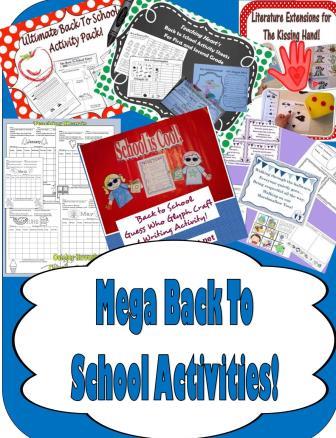
This MEGA Back to
School Bundle is a huge savings! You get the
following items all in one download. Back to
School Made Easy for
sure!!
Apple Themed Math and Reading Set - Regular 7.99
for 13+ pages
Back to School Glyph - Regular 5.99 for 10+ pages
Calendar Activity Sheets - Regular 3.00
First Day of School Worksheets and Story
Organizer for First and Second
Grade - Regular 6.99 for 20+ pages
The Kissing Hand Literature Extensions, Centers,
Games, and
Worksheets - Regular 6.99 for 30+ pages
Ultimate Back To School Activities for the First
Week! - Regular 12.99
for 22+ pages
Following Direction or Listening Skills Extra
Practice Sheets - Regular
2.00 for 8+ pages
Each Item if Purchased Would Cost $45.00 total.
Save $15.00 getting
them all together for $30.00
Copyright Colleen Gallagher 2013 - Teaching
Heart:
Click here to
order!
|

|


![]()
![]()
![]()
![]()
